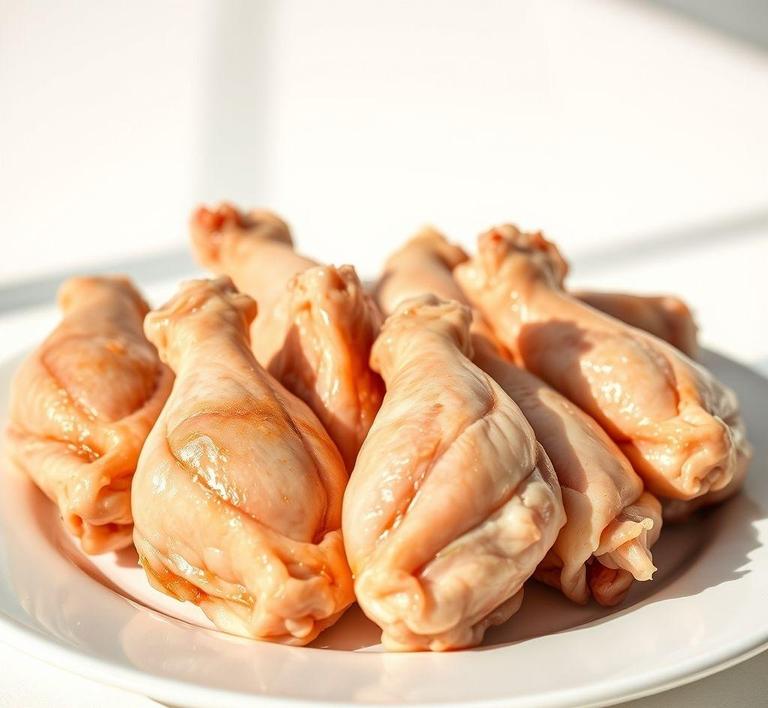Ever found yourself with extra uncooked chicken wings that you just aren’t able to cook in time? Well, don’t worry, you can refreeze them, but there are a few things you need to know to do it safely and effectively. Refreezing uncooked chicken wings can save you from food waste, but it requires careful handling to maintain both flavor and safety. In this guide, we’ll walk you through everything you need to consider-like how to store them, how long they last in the freezer, and tips to keep them fresh and safe for when you’re ready to cook up a batch of crispy, juicy wings!
Can You Refreeze Uncooked Chicken Wings?

Yes, you can refreeze uncooked chicken wings-but only under specific conditions. Food safety guidelines, particularly those issued by the USDA, state that it is safe to refreeze raw meat, including poultry, if it has been thawed in the refrigerator and has not exceeded 40°F (4°C). The crucial factor here is temperature control. If the wings were thawed on the counter, in warm water, or by any method that allowed them to enter the ‘danger zone’ (between 40°F and 140°F), they should not be refrozen, as bacterial growth may have already begun.
This guideline exists to protect against foodborne illnesses caused by pathogens such as Salmonella and Campylobacter. These bacteria can multiply rapidly when chicken is exposed to temperatures above 40°F, even for a short period. So, if you thawed your wings safely in the refrigerator and they’ve remained cold, you’re in the clear to refreeze them. However, doing this repeatedly can have consequences on quality, which we’ll explore shortly.
How To Refreeze Uncooked Chicken Wings?
Refreezing uncooked chicken wings is not complicated, but doing it the right way ensures both food safety and the preservation of flavor and texture. Follow these step-by-step guidelines:
-
Assess the Wings’ Condition:
- First, ensure the chicken wings have been thawed in the refrigerator and kept at a safe temperature (below 40°F).
- Check for any off odors, sliminess, or discoloration-these are signs of spoilage, and such wings should be discarded, not refrozen.
-
Pat Dry to Prevent Ice Crystals:
- Before refreezing, gently pat the wings dry with a paper towel. Excess moisture leads to ice crystal formation, which can degrade texture during refreezing.
-
Package Properly:
- Use airtight, freezer-safe bags or vacuum-seal packaging to minimize exposure to air and freezer burn.
- Press out as much air as possible if using zip-top freezer bags.
-
Label Clearly:
- Always label the packaging with the current date. This helps track how long the wings have been in the freezer and ensures you use them within a safe time frame (ideally within 3-4 months for best quality).
-
Freeze Promptly:
- Place the packaged chicken wings in the coldest part of your freezer. Avoid storing them in the freezer door, where temperature fluctuations are more likely to occur.
Quality Impact
While refreezing uncooked chicken wings is generally safe when done properly, the impact on quality is where you may notice a difference. The freezing and thawing process can cause cellular damage to the meat. As the water within the cells of the chicken wings freezes, it expands into ice crystals. Upon thawing, these crystals rupture the muscle fibers, causing moisture loss. The result? Chicken wings that are drier and less tender than their never-frozen counterparts.
Refreezing amplifies this issue. A second freeze-thaw cycle increases the formation of ice crystals and further degrades the structure of the meat. You may find the wings less juicy, slightly rubbery in texture, and not as flavorful-especially if they were stored improperly. While this won’t affect safety, it can impact your culinary experience, particularly in dishes where texture plays a starring role, such as crispy fried wings or grilled recipes.
To mitigate this quality loss:
- Consider marinating the wings before refreezing; acidic or oil-based marinades can help tenderize the meat and lock in moisture.
- Alternatively, cook the thawed wings before freezing again. Cooked chicken handles freezing better than raw, especially if incorporated into saucy or broth-based dishes.
Yes-you can refreeze uncooked chicken wings, provided they’ve been thawed properly and kept at safe temperatures throughout the process. The key lies in mindful handling: always thaw in the refrigerator, act quickly, and store with care. While safety is not usually compromised by refreezing, quality certainly can be. Expect some textural changes, especially after multiple freeze-thaw cycles.
To ensure you’re getting the most out of your chicken wings-whether baked, fried, grilled, or smoked-aim to minimize the number of times they’re frozen and thawed. When in doubt, cook before freezing, and always prioritize safety over salvage. With careful planning, your wings can still soar in flavor, even after a return trip to the freezer.
Is It Safe To Refreeze Uncooked Chicken Wings?
Refreezing uncooked chicken wings can be safe-but only under very specific conditions. The key determinant is how the chicken wings were handled after their initial thawing. If they were thawed in the refrigerator and kept at or below 40°F (4°C) the entire time, then it is generally safe to refreeze them. The USDA affirms this practice, emphasizing that refreezing poultry that has been safely thawed and kept cold poses minimal risk.
However, the safety and quality of the chicken wings may diminish with each freeze-thaw cycle. While freezing halts bacterial growth, it doesn’t kill all bacteria. If the chicken is left at room temperature or even in a ‘danger zone’ (between 40°F and 140°F) for too long, bacteria like Salmonella and Campylobacter can proliferate quickly, making the meat unsafe to eat or refreeze.
Texture and moisture loss are also concerns. With every cycle of freezing and thawing, the muscle fibers in the wings break down, leading to a mushier texture and drier meat. This might not be a deal-breaker for soup or stew recipes, but for crispy fried or grilled wings, it can impact the final quality considerably.
Signs That Uncooked Chicken Wings Should Not Be Refrozen
Sometimes, the chicken wings sitting in your fridge or on your countertop might appear fine at first glance-but careful inspection is crucial. Here are the most important warning signs that chicken wings are no longer safe to refreeze, or even consume:
-
Unpleasant Odor
The nose knows. Spoiled chicken emits a strong, sour, or even ammonia-like smell that is unmistakably foul. If you detect an off odor, discard the wings immediately.
-
Slimy or Sticky Texture
Fresh chicken should feel slightly moist but not slimy. A sticky or tacky coating indicates bacterial activity and spoilage. If you feel a film on the wings, it’s time to toss them.
-
Discoloration
Fresh chicken wings are typically pale pink. If the color has turned gray, greenish, or shows patches of yellowing, spoilage is likely. Freezer burn-while not unsafe-is another visual clue that the wings may have degraded in quality. Look for white, dried-out spots or ice crystals.
-
Time Left at Room Temperature
If uncooked chicken wings were left out for more than two hours (or one hour in hot weather), they are no longer safe. Bacteria multiply rapidly at room temperature, and refreezing at this point won’t undo potential contamination.
-
Previous Thawing Method
If you thawed the chicken wings using hot water or on the countertop (two unsafe methods), do not refreeze them. These techniques allow uneven thawing and can promote rapid bacterial growth.
Common Refreezing Mistakes
Even the most seasoned home cooks can slip up when handling raw poultry. Avoiding the following mistakes can help you maintain food safety and quality:
-
Thawing at Room Temperature
Perhaps the most common mistake. Never thaw chicken wings on the counter. This creates an ideal environment for bacteria to grow even if the center of the meat remains frozen.
-
Refreezing After Partial Cooking
Chicken that has been partially cooked should never be refrozen. Partially heating the meat can leave portions of it in the ‘danger zone’ for bacterial growth without killing pathogens.
-
Refreezing After Multiple Days in the Fridge
If chicken wings have been thawed and left in the fridge for more than 1-2 days, their freshness is compromised. Even though they were refrigerated, their bacterial load may have increased, making refreezing unsafe.
-
Not Labeling and Dating
Many people forget to label their frozen meats with dates. This can lead to long-term storage of food past its peak safety and quality. Chicken should ideally be used within 9 months of freezing.
-
Repeated Freeze-Thaw Cycles
Constantly thawing and refreezing can degrade meat to the point of being unsafe or unpalatable. Each thaw cycle increases the risk of contamination and deteriorates the texture and flavor.
🛠 Tips And Tricks For Safe Refreezing
Mastering food safety doesn’t require a culinary degree-just a little attention to detail and planning. These handy tips and best practices can help you avoid waste and maintain optimal quality:
-
Always Thaw in the Refrigerator
This is the safest method by far. It may take longer, but it keeps the meat consistently below 40°F. Plan ahead: it typically takes 24 hours for a full pound of chicken to thaw this way.
-
Use Air-Tight Packaging
If you plan to refreeze the wings, make sure they’re stored in vacuum-sealed or freezer-safe bags with as much air removed as possible. This reduces freezer burn and protects flavor.
-
Portion Before Freezing
Instead of freezing one large batch, divide the chicken wings into meal-sized portions. That way, you only thaw what you need, avoiding unnecessary refreezing.
-
Label and Date Every Time
Use a permanent marker to note the original freeze date and any refreeze dates. Most chicken wings maintain their best quality for up to 9 months, though they’re safe indefinitely at 0°F.
-
Consider Cooking First
If you’re unsure about refreezing raw chicken, cook it first. Fully cooked chicken can be refrozen more safely, and it gives you a convenient protein option for future meals.
Conclusion
Refreezing uncooked chicken wings is not inherently dangerous-but it requires careful attention to time, temperature, and handling practices. If the wings were thawed safely in the fridge and haven’t lingered beyond two days, then refreezing them is typically safe. However, one should never ignore signs of spoilage, as foodborne illnesses linked to raw poultry can be serious.
By following proper thawing methods, avoiding cross-contamination, and recognizing when chicken has turned bad, you can ensure both the safety and flavor of your meals. Whether you’re prepping for game day or a quiet weeknight dinner, understanding the dos and don’ts of refreezing can save you money, reduce waste, and keep your kitchen a safe space for culinary creativity.


